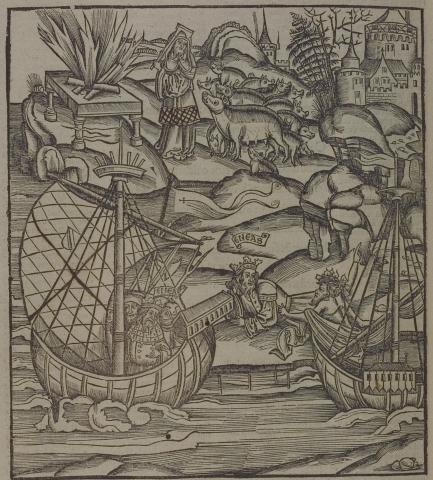Annotations
In the lower middle of the image, Aeneas lies sleeping by the ships (26-30). The River God Tiber appears to him in a dream, wearing a wreath of poplar leaves and a light flowing garment (31-5). He reassures Aeneas that he is meant to found a city here and tells Aeneas to look for a white sow with thirty piglets as proof of the prophecy (36-49). He points, urging Aeneas to sail to Pallanteum, which may be the city in the upper right corner (51-64). To the lower left, Aeneas and a crew have boarded one of two ships that will make the journey up the river to Pallanteum (79-80). In the upper left, Aeneas stands holding an axe between a large altar and a sow with a litter of thirty offspring. He prepares to sacrifice the pigs to Juno, in an attempt to appease the goddess's anger (81-5). (Katy Purington)
Woodcut illustration from the “Strasbourg Vergil,” edited by Sebastian Brant: Publii Virgilii Maronis Opera cum quinque vulgatis commentariis expolitissimisque figuris atque imaginibus nuper per Sebastianum Brant superadditis (Strasbourg: Johannis Grieninger, 1502), fol. 310v, executed by an anonymous engraver under the direction of Brant.


Sebastian Brant (1458-1521) was a humanist scholar of many competencies. Trained in classics and law at the University of Basel, Brant later lectured in jurisprudence there and practiced law in his native city of Strasbourg. While his satirical poem Das Narrenschiff won him considerable standing as a writer, his role in the transmission of Virgil to the Renaissance was at least as important. In 1502 he and Strasbourg printer Johannes Grüninger produced a major edition of Virgil’s works, along with Donatus’ Life and the commentaries of Servius, Landino, and Calderini, with more than two hundred woodcut illustrations. (Annabel Patterson)